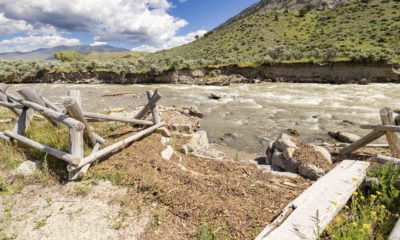Uncategorized
The New West: Idaho boy nearly becomes casualty of war waged on predators
Published
8 years agoon
Posted By
Outlaw PartnersMost readers here have probably never heard of the notorious “M-44.” It’s not a gun, but rather a different kind of weapon deployed by the U.S. government in its century-old campaign still being waged against wildlife predators.
This is how the U.S. Department of Agriculture’s predator-killing bureau, Wildlife Services, describes the function of M-44s: “The M-44 device is triggered when a canid (i.e. coyote or wild dog) tugs on the baited capsule holder, releasing the plunger and ejecting sodium cyanide powder into the animal’s mouth. The sodium cyanide quickly reacts with moisture in the animal’s mouth, releasing hydrogen cyanide gas. Unconsciousness, followed by death, is very quick, normally within 1 to 5 minutes after the device is triggered. Animals killed by sodium cyanide appear to show no overt signs of distress or pain.”
Repeat that last line again, italics placed here for emphasis: “Animals killed by sodium cyanide appear to show no overt signs of distress or pain.”
Should that give us solace?
Only days ago, as 14-year-old Canyon Mansfield was playing with his beloved Labrador friend, Casey, in the hills above Pocatello, Idaho, both teenage boy and dog stumbled unsuspectingly upon an M-44-like device that later was described as detonation of a “cyanide bomb.” The encounter killed the family pet that came in contact with cyanide and left Canyon’s clothing covered with chemical residue, prompting the local sheriff to declare him “lucky to be alive.”
Of course, the boy’s parents are rightfully outraged. Other recent tragic incidents involving M-44s and pets in Wyoming, plus a wolf killed by an M-44 this February in Oregon, and a longer list of additional events that the government calls unfortunate accidents, are refueling public anger over M-44s, prompting Rep. Peter DeFazio, D-Ore., to renew his push for a total ban.
While Wildlife Services and its cooperating local and state collaborators tout the lethal effectiveness of poisoning to death intended prime targets—especially coyotes given that we are now again in the middle another domestic sheep lambing season in the West—the dangers of M-44s are undeniable, critics say.
Namely, M-44s are menacingly super toxic and non-discriminating; in many cases needlessly used, especially on public land; and hazardous to the health of humans and pets.
Most of all, notes Brooks Fahy, a founder of the organization Predator Defense, and a national leader in pushing to have M-44s outlawed, their deployment “reflects an archaic mindset carried forward by a federal agency out of touch with 21st century values,” he says.
A few years ago, Predator Defense produced a documentary “Exposed: USDA’s Secret War on Wildlife,” that won a number of awards and even drew praise from legendary conservationist Dr. Jane Goodall.
“What we desperately need is serious, objective, and transparent oversight of Wildlife Services by Congress but we haven’t had it because of Republican resistance to scrutiny of the agency’s tactics, especially from lawmakers in the rural West,” Fahy claims. “They don’t want to know the truth; they don’t want their constituents to know the truth. They’re invested in promoting baseless propaganda which reinforces negative generalizations about predators that are just not factual.”
As numerous studies note, predator control may indeed be a culturally engrained tradition in rural corners of the West, but its rationale does not always align with the conclusions of science. In some places, costly intervention by Wildlife Services has actually made predator conflicts worse and they’ve resulted in the killing of non-target species. In addition, as research makes clear, predators—including wolves, cougars, bears and coyotes—are actually important in helping to slow the spread of diseases in wildlife, such as chronic wasting disease, because predators target sick animals.
Although Wildlife Services insists that M-44s are safe and subject to 26 different “use restrictions” mandated by the U.S. Environmental Protection Agency (note: some Western lawmakers are now working to gut EPA’s role as a regulatory agency), Fahy says the agency and, in particular, state partners and private contractors have checkered records as noted in his documentary mentioned above.
On the USDA website, it states that “Wildlife Services personnel place M-44s along game and livestock trails, ridges, fence lines, seldom-used ranch roads, coyote and fox natural travel ways, rendezvous sites, and territorial marking sites/locations. Trained personnel inspect each M-44 at least weekly. Used mostly in the winter and spring, M-44s may be used year-round in some locations. When not in use, they are stored in secured, locked locations.” (Read more here)
Fahy notes the irony that M-44s are “stored in secured, locked locations” yet as the Mansfield incident points out, they were sloppily deployed in a location that nearly cost a teenager his life.
There are instances, though extraordinarily rare and only as a last resort, Fahy acknowledged, where depredation of livestock, particularly on private land, can be a problem that must be resolved through lethal removal. But he and others argue that many conflicts on public land can be better resolved through more conscientious sheep and cattle management; vigilant deployment of non-lethal deterrents such as guard dogs, range riders and fladry—or flagging strung on wire fencing shown in many instances to effectively ward off predators—especially during calving and lambing seasons; and acknowledgment that the publicly-subsidized grazing of private livestock on public lands is a privilege.
Predator Defense is among several organizations pushing to reform how Wildlife Services does business. Together, they have also sought tighter restrictions on trapping to reduce the number of pets caught in leg-hold and conibear traps near towns and reducing the killing of non-target species such as imperiled wolverines and lynx.
“With M-44s, it’s kind of like allowing a person with a loaded Glock to put a gun down on a picnic table in a public park along with a sign that reads, ‘Dangerous, do not touch.’ What would we be thinking if government agencies allowed that to happen?” Fahy says. “M-44s are more dangerous than a gun. You breathe some of this stuff in, and you’re dead.”
Todd Wilkinson is an award-winning journalist who has been writing about the West for more than 30 years and his column the New West has been widely read in the Greater Yellowstone region for nearly as long. He writes his column every week, and it’s published on explorebigsky.com on EBS off weeks. You can also read his latest book, “Grizzlies of Pilgrim Creek,” a story about famous Greater Yellowstone grizzly 399 featuring photographs by Thomas Mangelsen.
The Outlaw Partners is a creative marketing, media and events company based in Big Sky, Montana.


Upcoming Events
november, 2024
Event Type :
All
All
Arts
Education
Music
Other
Sports
Event Details
Spanish Classes with World Language InitiativeThese unique, no cost Spanish classes are made possible by the contribution of Yellowstone Club
more
Event Details
Spanish Classes with World Language InitiativeThese unique, no cost Spanish classes are made possible by the contribution of Yellowstone Club Community Foundation (YCCF) and Moonlight Community Foundation (MCF). This class will focus on building a lifelong affinity for world languages and cultures through dynamic and immersive Communicative Language teaching models.
Beginner Class – Mondays and Wednesdays from 5:30-6:30 pm
Intermediate Class – Mondays and Wednesdays from 6:45- 7:45 pm
- Classes begin Oct.7, 2024 and run for 6 weeks
- Class size is limited to 12 students
- Classes are held in Big Sky at the Big Sky Medical Center in the Community Room
For more information or to register follow the link below or at info@wlimt.org.
Time
October 21 (Monday) 5:30 pm - November 27 (Wednesday) 7:45 pm
Location
Big Sky Medical Center - Community Room (2nd Floor)
Big Sky Medical Center - Community Room (2nd Floor)
Event Details
Spanish Classes with World Language InitiativeThese unique, no cost Spanish classes are made possible by the contribution of Yellowstone Club
more
Event Details
Spanish Classes with World Language InitiativeThese unique, no cost Spanish classes are made possible by the contribution of Yellowstone Club Community Foundation (YCCF) and Moonlight Community Foundation (MCF). This class will focus on building a lifelong affinity for world languages and cultures through dynamic and immersive Communicative Language teaching models.
Beginner Class – Mondays and Wednesdays from 5:30-6:30 pm
Intermediate Class – Mondays and Wednesdays from 6:45- 7:45 pm
- Classes begin Oct.7, 2024 and run for 6 weeks
- Class size is limited to 12 students
- Classes are held in Big Sky at the Big Sky Medical Center in the Community Room
For more information or to register follow the link below or at info@wlimt.org.
Time
October 28 (Monday) 5:30 pm - December 4 (Wednesday) 7:45 pm
Location
Big Sky Medical Center - Community Room (2nd Floor)
Big Sky Medical Center - Community Room (2nd Floor)
Event Details
Spanish Classes with World Language InitiativeThese unique, no cost Spanish classes are made possible by the contribution of Yellowstone Club
more
Event Details
Spanish Classes with World Language InitiativeThese unique, no cost Spanish classes are made possible by the contribution of Yellowstone Club Community Foundation (YCCF) and Moonlight Community Foundation (MCF). This class will focus on building a lifelong affinity for world languages and cultures through dynamic and immersive Communicative Language teaching models.
Beginner Class – Mondays and Wednesdays from 5:30-6:30 pm
Intermediate Class – Mondays and Wednesdays from 6:45- 7:45 pm
- Classes begin Oct.7, 2024 and run for 6 weeks
- Class size is limited to 12 students
- Classes are held in Big Sky at the Big Sky Medical Center in the Community Room
For more information or to register follow the link below or at info@wlimt.org.
Time
November 4 (Monday) 5:30 pm - December 11 (Wednesday) 7:45 pm
Location
Big Sky Medical Center - Community Room (2nd Floor)
Big Sky Medical Center - Community Room (2nd Floor)










